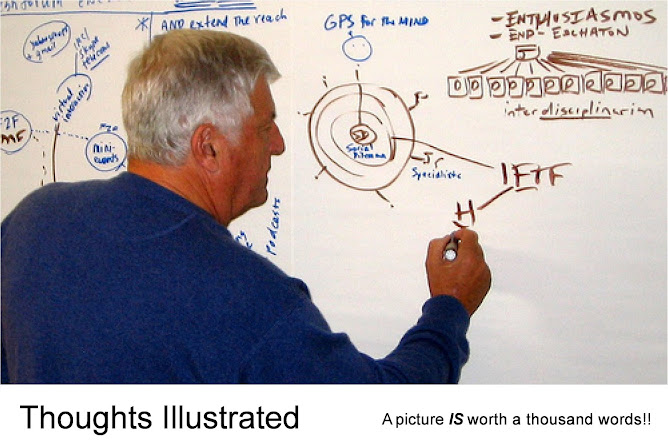Under the "covers" of Blogger, Picasa has been automatically collecting the images I use in the TI blog. Today I reviewed the 120 images collected by Picasa, giving me a "map of cognition" spanning the illustrations I have used to illuminate my posts over the past 14 months.
The review of this map of cognition was triggered by my attempt to understand a key point in David Weinberger's book
Everything is Miscellaneous (my acronym E=M)

Step 1 - above - depicts my review of the Picasa image collection using a drawing by Barcelona sketch artist Joan Mas from her sketch book on GTD which I found last year courtesy of Karen Bennett.
Step2 -From the miscellaneous(but remixable/reconstructable) Thoughts Illustrated image collection in Picasa, I selected the one below also drawn by Joan Mas, which I then linked back
Thoughts Illustrated: GTD -Because getting organized should be fun.
Now there must be a way to connect the "pipes" of Picasa and Blogger to enable me to
grok my TI archives visually - and engage with David in conversation about his filtering concept (p 103 Everything is Miscellaneous - E=M) using images to express my thoughts and to enable this while I am "IN" blogger! (
As of May 3, 2008 this function is not yet enabled and may take a google API hacker to create it)
It would show the power of E= M more effectively if I could make the link to p 103 while I was posting this - and even more effective a "reconstruction" of my TI archive if I could link to this post on CPA automatically.
Thoughts Illustrated: The Creative Tension of CPAI wonder if this RSS-able collection of links could be dragged and dropped onto a Grazr Widget and serve as a conversation "platform" for asking David - what do you
mean by that statement? Is my excursion through my own archival material
filtering on the way out- or as I am led to conclude - is it like this......?
Step 1 -
Panning - Scan the image collection from TI posts
Step 2 -
Zooming- Find the Joan Pas image I posted on GTD and Conversation
Step 3 -
Linking - Reconstructing from the TI reverse chronological archive ( blogsearch)
Step 4 -
Posting - Creating this new blog post - starting the conversation
Step 5 -
Notifying - Sending David a notice of this post
Step 6 -
Waiting - Hoping that David will respond and comment (conversation)
If
E=M text was digital and searchable, it would begin to make the concept of networking David's book much more useful. because the conversations that can be stimulated and peer produced from
E=M readers can add significant value in helping David's central memes survive and find utility in our complex world. (
This would also be true if David Allen's GTD was distibuted in ebook form for linkage and mashups)Finally, to give thanks to the original connection to Joan Mas images, the original link was from Karen Bennett
Picture It Solved - a visual approach to thinkingI was pleased to see Karen and her new husband at the Vizthink conference in January.
Note:Misspelling of Joan Mas in this post has been corrected from "Pas" to "Mas" wherever the misspelling occured in the original post Sorry Joan.




















![[090307+armano.jpg]](https://blogger.googleusercontent.com/img/b/R29vZ2xl/AVvXsEg49aH4-fXUb_nYOVWHU83mcvKjubhJN3FIlgxpc-kBBWsT9nbdOUhxYkQI7BLHKHHtLu648O0Ji0jAZBt26Rns1YgUJH55gy_tSnRLh0dyrvIfUy4tib30sKBw_anDlLjQbsk/s1600/090307+armano.jpg)



























